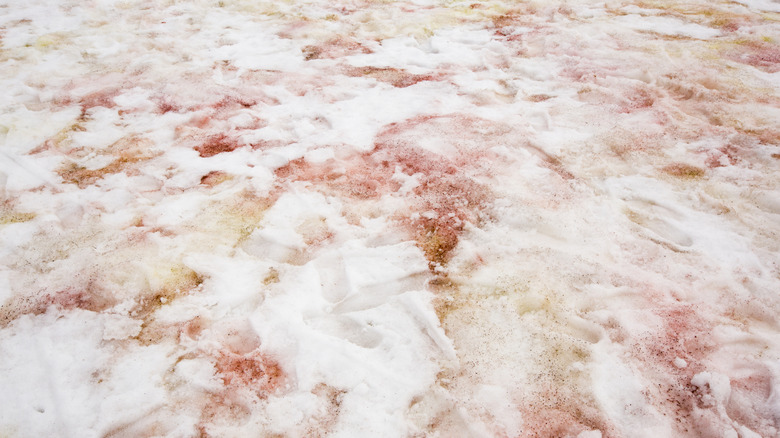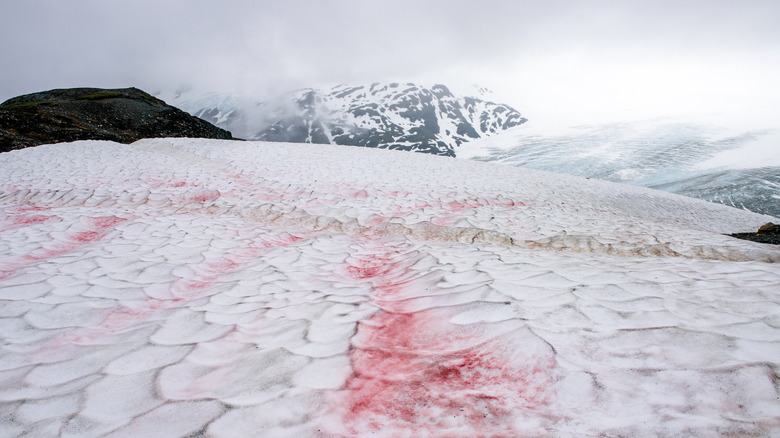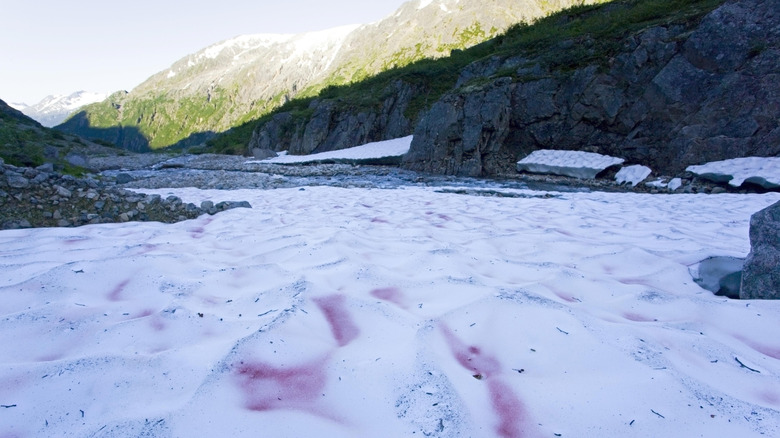The Mystery Of California's Pink 'Watermelon Snow' And Where To Find It
Before we start, let's be clear that "watermelon snow" isn't a granita flavor or the latest cocktail trend on TikTok. In fact, it has little to do with the ubiquitous summer melon — well, except for the reddish-pink hue and faint sweet smell. But, even that's a bit of a stretch. It's known by many names, including "pink snow," "red snow," and the far more haunting "blood snow;" but "watermelon snow" is actually a natural process caused by feisty algae known as Chlamydomonas nivalis. Although these cold-loving algae appear green under a microscope, they have an additional pigment that gives the algae (and the snow) a reddish or pink hue — although the colors vary.
"(The algae is) normally in this kind of dormant cyst form, and when there's enough meltwater in the snowpack and enough nutrients, like during spring, that cyst form is triggered out of dormancy," Utah State University assistant professor and climate resiliency specialist Scott Hotaling explained to CNN.
However, the red bloom isn't triggered only by access to nutrients and melting snow waters, it's also connected to temperature increases. The red pigment acts as a sunscreen of sorts for the microorganisms, protecting them from harsh ultraviolet rays. In short, the red pigment serves a similar purpose to melanin in human skin.
Is watermelon snow dangerous?
With a name as appetizing as "watermelon snow," it's no wonder many people want to know if you can eat it. According to specialists, ingesting watermelon snow may lead to digestive issues; namely, it causes a laxative effect. Also, you can't know whether the algae are contaminated with bacteria or substances that could make humans sick. Just as your parents taught you not to eat yellow snow, you should steer clear of pink and red snow, too.
While observing watermelon snow in the wild doesn't pose a threat to humans, these algae blooms contribute to ice melt, sea level rise, flooding, and global climate change. According to experts at Ocean Conservancy, "The addition of color to the translucent snow causes it to absorb more heat rather than reflect, which ultimately leads to faster melting rates." Although this might not be a massive problem at the most popular ski resorts in America, it's dangerous in areas already experiencing rapid ice melt, including Antarctica and Greenland.
Find watermelon snow in Yosemite and beyond
Those curious about watermelon snow can find it on permanent snowfields across the U.S. and internationally during the warm summer months. For instance, rangers in Yosemite National Park reported finding watermelon snow at an elevation of 9,500 feet at the end of August. Although there's no guarantee you'll encounter algae blooms, they usually develop in areas with persistent snow, including high elevations, glaciers, frozen lakes, or other places with year-round ice or snow.
If you live in the U.S., you have the best chance of seeing watermelon snow in the Sierra Nevadas or Cascade Range. Plus, you can drive through these West Coast mountain ranges on this stunning road trip route. We also recommend checking the Facebook pages of national and state parks in these areas for timely updates about blooms. However, keep in mind that watermelon snow often forms in hard-to-access areas, so you should always exercise caution and review hiking safety tips that everyone should know before hitting the trails.


